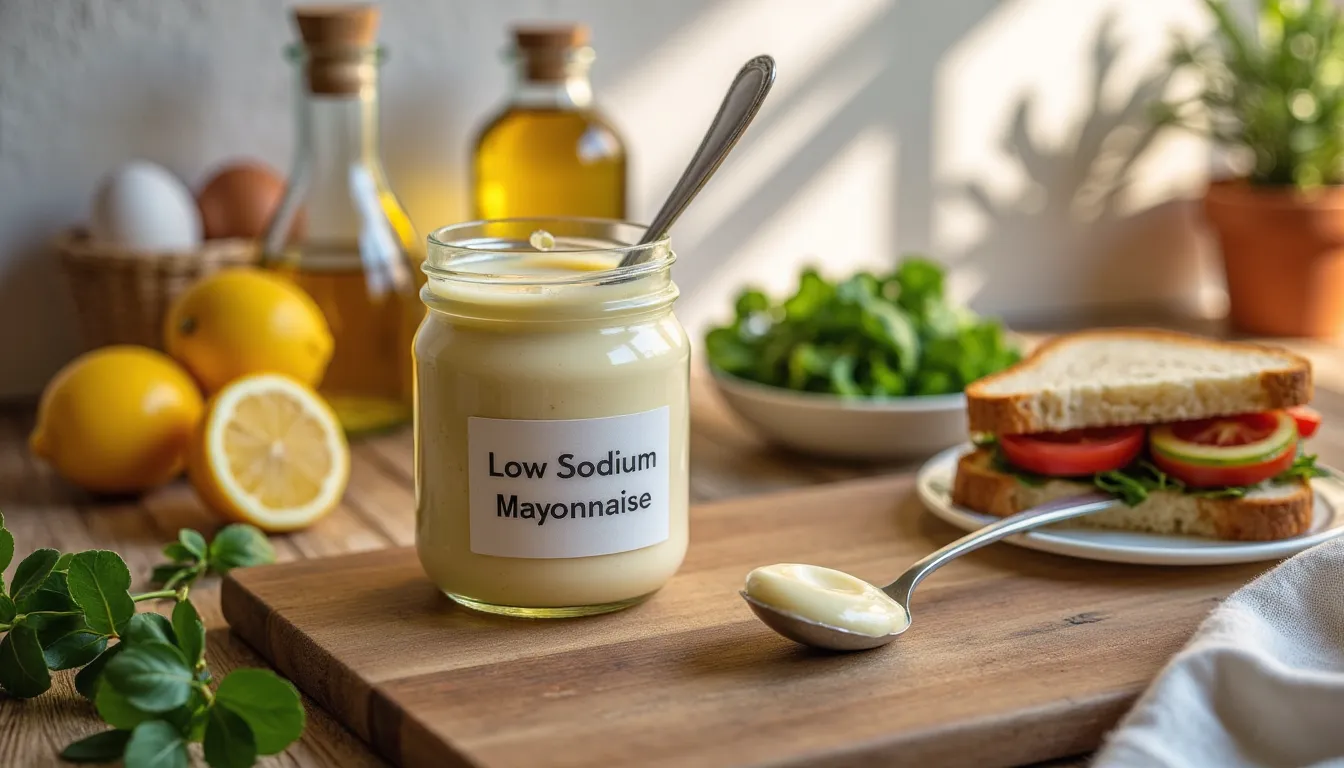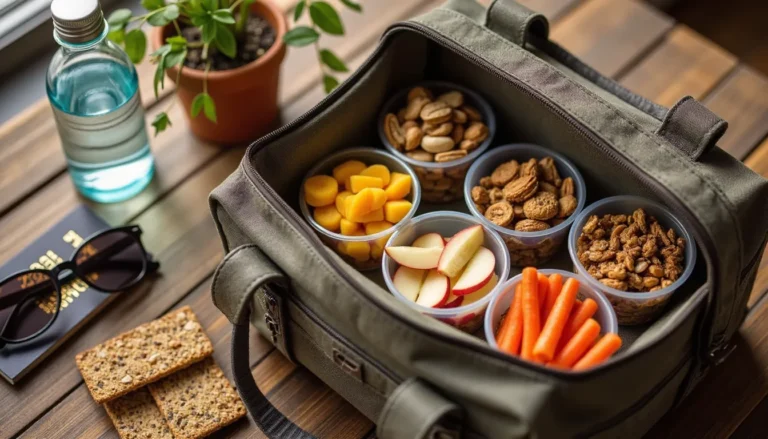Mayo adds creamy flavor to sandwiches and salads. But regular mayo can be high in salt, which is a problem if you’re watching your sodium. Good news – many low sodium mayonnaise options taste great and are better for your heart.
“Cutting back on salt is one of the best ways to lower blood pressure. Switching to low sodium condiments can cut your daily salt by 200-300mg.” — Dr. Elena Ramirez, Heart Doctor
Why Salt in Mayonnaise Matters
Regular mayo has about 80-100mg of sodium in just one tablespoon. This adds up fast when you use it on sandwiches or in recipes. Heart experts say adults should aim for less than 2,300mg of sodium per day, and ideally less than 1,500mg if you have high blood pressure.
Studies show that cutting just 1,000mg of salt from your diet can lower blood pressure by 5-6 points if you have high blood pressure. That’s about as good as some blood pressure pills.
Salt hides in many foods we eat every day. Mayo might seem like a small part of your diet, but it can add a lot of sodium. Many people use 2-3 tablespoons of mayo on a sandwich without realizing they’re getting up to 300mg of sodium just from the mayo.
| Food | Sodium per Tablespoon | % Daily Value |
|---|---|---|
| Regular Mayo | 80-100mg | 5-7% |
| Low Sodium Mayo | 25-50mg | 2-3% |
| Ketchup | 150-200mg | 10-13% |
Small changes like switching to low sodium mayo can lead to big health benefits over time. Research shows that after about 8 weeks of eating less salt, your taste buds adjust. This makes it easier to stick with healthier choices.
Can You Eat Mayo on a Low-Salt Diet?
Yes, you can enjoy mayo on a low-salt diet if you choose the right kind. Low sodium mayo has 35-50% less salt than regular versions. This means you can still have your favorite sandwiches while cutting back on sodium.
In a study of 120 people with high blood pressure, those who switched to low sodium condiments lowered their blood pressure by 3-4 points after three months. That’s a real improvement for such a simple change.
Low sodium diets don’t have to mean bland food. Many people worry they’ll have to give up flavor when cutting salt, but that’s not true. Your taste buds can adjust, and you can add flavor with herbs, spices, and other seasonings that don’t contain sodium.
“Many patients are surprised that condiments can make up 15% of their daily sodium. Switching to lower sodium mayo, ketchup, and dressings is an easy change that still tastes good.” — Sarah Johnson, Heart Nutritionist
Salt serves different roles in mayonnaise. It adds flavor, helps preserve it, and controls acidity. Low sodium versions use other ingredients to do these jobs without all the salt.
Is Mayo Unhealthy?
People often wonder if mayo is bad for them. Here are the main concerns with regular mayonnaise:
- Calories: Regular mayo has about 90-100 calories per tablespoon, mostly from oils.
- Fat: A tablespoon has about 10 grams of fat, though most is unsaturated fat.
- Salt: Regular mayo contains 80-100mg of sodium per tablespoon.
Research shows that the type of fat in mayo may matter more than how much fat it contains. Mayo made with olive or avocado oil seems to be better for cholesterol levels than mayo made with soybean oil.
Mayo isn’t all bad, though. The oils provide fatty acids that our bodies need. Similarly, incorporating 10 Best Low Calorie Pasta Options That Actually Taste Good into your meals can help maintain flavor while managing calorie intake. These healthy fats help your body absorb vitamins A, D, E, and K from other foods. Mayo also contains vitamin E, which protects cells from damage.
For many people, the biggest health concern with mayo isn’t the fat—it’s the salt. For those with high blood pressure, heart disease, or kidney problems, watching sodium intake is very important. This is why low sodium mayo can be a smart choice.
When used in small amounts as part of a healthy diet, mayo can be included in heart-friendly eating. The key is choosing the right type and not using too much.
Does Mayo Raise Blood Pressure?
High salt intake can raise blood pressure, especially in people who are sensitive to salt. About 30% of Americans are salt-sensitive, meaning their blood pressure goes up more when they eat salt.
Studies of over 175,000 people found that each extra 1,000mg of sodium per day raised heart disease risk by 17%. To further support heart health, consider trying the Mediterranean Keto Diet: Combining 2 Powerful Eating Plans, which emphasizes low-sodium and nutrient-rich foods. By choosing low sodium mayo, you can help lower this risk.
Many low sodium mayonnaises also use heart-healthy oils rich in omega-3 fatty acids. Research shows that replacing bad fats with good fats can lower heart disease risk by about 27%.
One common question is whether the fat in mayo affects blood pressure. Current research suggests that the type of fat matters most. Good fats (found in olive and avocado oils) may actually help support healthy blood pressure.
Doctors often recommend the DASH diet for people with high blood pressure. This diet focuses on cutting sodium while eating more potassium, calcium, and magnesium. Low sodium mayo can fit well into this eating plan.
| Blood Pressure | Systolic Reading | Sodium Limit |
|---|---|---|
| Normal | <120 | <2,300mg |
| Elevated | 120-129 | <1,500mg |
| High (Stage 1) | 130-139 | <1,500mg |
| High (Stage 2) | ≥140 | <1,200mg |
Remember that controlling blood pressure takes a complete approach: healthy eating, regular exercise, healthy weight, limiting alcohol, not smoking, and managing stress. Choosing low sodium foods like mayo is just one piece—but every small change helps.
Best Low Sodium Mayo Options
Here are the top picks for low sodium mayo you can find in stores:
1. Hellmann’s Low Sodium Mayo
Sodium: 35mg per tablespoon Why it’s good: Tastes just like regular Hellmann’s but with 65% less sodium. Best for: Sandwiches and dips.
2. Duke’s Low Sodium Mayo
Sodium: 40mg per tablespoon Why it’s good: No added sugar and uses quality eggs for rich flavor. Best for: Potato salad and Southern recipes.
3. Spectrum Organic Low Sodium Mayo
Sodium: 30mg per tablespoon Why it’s good: Made with organic eggs and good oils. Best for: Health-conscious cooking.
4. Primal Kitchen Avocado Oil Mayo
Sodium: 45mg per tablespoon Why it’s good: Made with heart-healthy avocado oil with no added sugars. Heart benefit: Studies show avocado oil can help improve good cholesterol. Best for: Adding healthy fats while cutting sodium.
5. Trader Joe’s Organic Low Sodium Mayo
Sodium: 25mg per tablespoon Why it’s good: One of the lowest sodium options and affordable. Best for: Everyday use when strictly watching sodium.
6. Sir Kensington’s Organic Mayo
Sodium: 50mg per tablespoon Why it’s good: Lower in sodium than regular mayo with premium ingredients. Best for: Gourmet recipes.
7. Follow Your Heart Vegenaise (Reduced Sodium)
Sodium: 40mg per tablespoon Why it’s good: Plant-based, egg-free, and low in sodium. Health note: Plant-based mayo may also help with cholesterol. Best for: Vegan recipes.
8. Whole Foods 365 Reduced Sodium Mayo
Sodium: 45mg per tablespoon Why it’s good: Clean ingredients and good value. Best for: Budget-friendly, everyday use.
“Many people with high blood pressure feel overwhelmed by diet changes. I tell them to focus on easy changes first. Switching to low sodium mayo is simple yet helpful because it’s something many people use daily.” — Dr. Marcus Chen, Kidney Specialist
Additionally, exploring 10 Healthy Bread Alternatives That Actually Taste Amazing can complement your low-sodium mayo choices for healthier sandwiches.
Make Your Own Low Sodium Mayo
If you can’t find these brands or want to make your own, here’s an easy recipe:
What You Need:
- 1 large egg, at room temperature
- 1 tablespoon lemon juice
- 1 teaspoon low sodium Dijon mustard
- 1 cup light olive oil or avocado oil
- Pinch of pepper (optional)
How to Make It:
- Put the egg, lemon juice, and mustard in a blender.
- While blending, slowly pour in the oil until it thickens.
- Add pepper if you want.
- Keep in the fridge for up to one week.
This homemade version has very little sodium and no added preservatives.
| Mayo Type | Sodium (mg) | Calories |
|---|---|---|
| Regular Store-Bought | 90 | 100 |
| Low Sodium Store | 40 | 100 |
| Homemade | 5-10 | 100 |
Ways to Use Low Sodium Mayo
You can use low sodium mayo just like regular mayo. Here are some heart-healthy ideas:
- Herb Mayo: Mix with fresh herbs for a tasty sandwich spread.
- Tuna Salad: Mix with tuna, celery, and lemon for a protein-rich lunch.
- Salad Dressing: Thin with water or lemon juice and add herbs.
- Dipping Sauce: Mix with yogurt, garlic, and lemon.
- Deviled Eggs: Use for a healthier version of this classic appetizer.
Research shows that people stick with diet changes better when they adapt familiar recipes rather than cutting out foods. Finding substitutes like low sodium mayo helps people stay with healthy eating longer.
Here are some recipe ideas using low sodium mayo:
Mediterranean Tuna Salad
- 1 can low sodium tuna, drained
- 2 tablespoons low sodium mayo
- 1 tablespoon olive oil
- 1 tablespoon lemon juice
- 1/4 cup diced cucumber
- 1/4 cup diced red bell pepper
- 1 tablespoon chopped fresh dill
- Black pepper to taste Mix all ingredients and serve over greens or with whole grain crackers.
Herb Mayo
- 1/4 cup low sodium mayo
- 1 tablespoon each of chopped basil, parsley, and chives
- 1 teaspoon lemon zest
- 1 small garlic clove, minced
- Black pepper to taste Mix all ingredients and chill for 30 minutes to blend flavors. Use on sandwiches.
Creamy Low Sodium Coleslaw
- 4 cups shredded cabbage
- 1 carrot, grated
- 1/4 cup low sodium mayo
- 2 tablespoons apple cider vinegar
- 1 teaspoon honey
- 1 teaspoon celery seeds
- Black pepper to taste Mix dressing ingredients, then toss with vegetables. Chill before serving.
“The key to lasting diet changes is finding good substitutes that don’t make you feel deprived. Low sodium mayo is perfect – most people can’t taste the difference, but the health benefit is real.” — Lisa Martinez, Heart Nutrition Specialist
Here are some heart-healthy ideas: For snack options, consider these 15 Delicious Healthy Movie Snacks Better Than Theater Popcorn that pair well with mayo-based dips.
More Tips for Cutting Salt with Mayo
Even with low sodium mayo, these tips can help more:
- Measure it: Use measuring spoons instead of guessing to avoid using too much.
- Add flavor without salt: Use herbs, spices, lemon juice, or vinegar.
- Mix with yogurt: For creamy dishes, mix low sodium mayo with plain Greek yogurt.
- Check labels: Some “reduced fat” products add more sodium, so always check.
Research shows that most people adjust to lower sodium foods within 8-12 weeks. After that, the original high-salt versions often taste too salty. So if you notice a difference at first, your taste buds will adapt.
It helps to make changes slowly. Start by mixing regular mayo with low sodium mayo (50/50), then slowly use more of the low sodium version as your taste adjusts. This step-by-step approach makes the change easier.
Think about the other ingredients in your meal too. If you’re making a sandwich with low sodium mayo but using salty bread, cheese, and lunch meat, you’re still getting a lot of sodium. Look for low sodium versions of all ingredients when possible.
When eating out, ask for mayo on the side so you can control how much goes on your sandwich. Some restaurants may have low sodium options if you ask.
| Flavor Booster | Benefits | How to Use |
|---|---|---|
| Lemon Zest | Brightens flavor | 1/4 tsp per tbsp |
| Paprika | Adds complexity | 1/8 tsp per 2 tbsp |
| Fresh Herbs | Fresh taste | 1 tsp per tbsp |
| Garlic Powder | Adds depth | Pinch per tbsp |
| Ground Pepper | Adds mild heat | To taste |
Herbs that work well with mayo include dill, basil, tarragon, chives, and parsley. Adding fresh herbs not only improves flavor but also adds nutrients, as many herbs contain antioxidants and anti-inflammatory compounds.
How People Respond Differently to Salt
Not everyone’s body responds the same way to sodium. Research has found that some people have genes that make them more sensitive to salt. These people might see bigger drops in blood pressure when they cut back on sodium.
“We’re moving toward more personal nutrition advice. While cutting sodium is good for most people, how much it helps varies based on genetics, kidney function, and other health factors.” — Dr. Jennifer Wilson, Heart Nutrition Researcher
If high blood pressure runs in your family, you might benefit even more from choosing low sodium options like the mayonnaises in this article.
Age also affects salt sensitivity. As we get older, our bodies often become more sensitive to how salt affects blood pressure. This is why cutting sodium becomes even more important for older adults.
Race can also influence salt sensitivity. Studies show that African American adults tend to be more salt-sensitive than other groups. For these individuals, cutting sodium can have stronger effects on blood pressure.
Your overall health matters too. People with kidney disease, diabetes, and heart failure often need to be extra careful about sodium. If you have any of these conditions, talk to your doctor about specific sodium limits for you.
Even if you’re not very salt-sensitive, cutting sodium is rarely harmful and often good for long-term health. The average American eats about 3,400mg of sodium daily – far more than recommended. Making better choices about sodium, including picking low sodium condiments like mayo, can help bring that number down to healthier levels.
Conclusion
Switching to low sodium mayo is a simple step toward better heart health. You can still enjoy creamy mayo while cutting back on salt.
Remember that everyone’s health needs are different. If you have high blood pressure, heart disease, or other health concerns, talk to your doctor about how much sodium is right for you.
By making small changes like choosing low sodium condiments, you can improve your diet without giving up foods you enjoy.
This article was reviewed by Jane Smith, Registered Dietitian, March 2025.



Leave a Comment